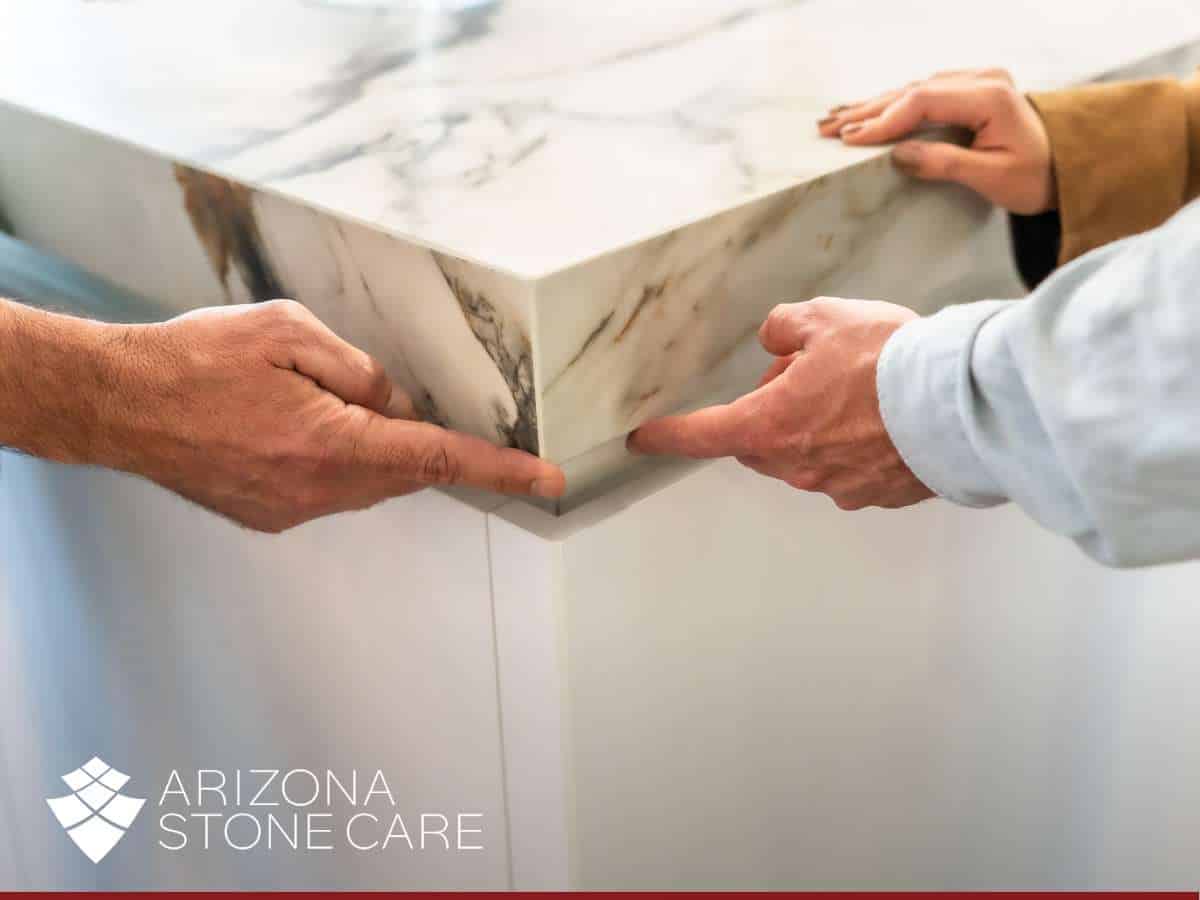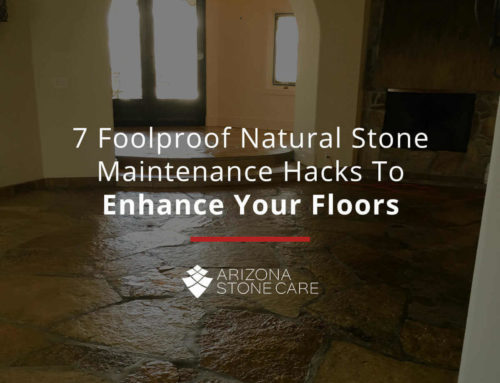How Do I Get Rid Of Watermarks & Etch Marks On My Stone Surfaces?
Protect Your Stone Surfaces From Watermarks & Etching
If you’re thinking about decorating your home with natural stone, you’re probably drawn to it because it’s one of the most beautiful, elegant, and timeless materials out there. The best part is that it can be used in countless ways. However, a few challenges may arise along the way. Among the most common are dealing with watermarks and etch marks on stone surfaces.
That’s why we want to show you not only how to prevent these marks but also how to remove them correctly if they’ve already appeared, without damaging the stone in the process.

Recognizing The Type Of Mark On Your Stone Surface
Before trying to fix the problem, it’s important to understand what you’re dealing with. There are two main possibilities: watermarks and etch marks. While they may look similar, they’re caused by very different factors.
- Watermarks are typically mineral deposits or residue left behind when water evaporates. Hard water, which contains calcium and magnesium, can leave behind cloudy rings or white spots, especially noticeable on polished stone surfaces like marble or granite. These spots usually sit on top of the surface and can often be removed with the right cleaning approach.
- Etch marks are more serious. They occur when acidic or alkaline substances —like lemon juice, vinegar, wine, or common cleaners with ammonia— touch stones containing calcium carbonate, such as marble or travertine. This reaction slowly dissolves a thin surface layer, leaving a dull, rough spot that feels slightly different to the touch.
Both types of marks can dull the beauty of your stone. However, watermarks usually affect only the surface, while etch marks actually alter the stone itself. Knowing which one you’re dealing with will help you choose the right solution. This prevents the problem from getting worse, not only for your stone but also for the surrounding areas during the natural stone restoration process.
With that in mind, how can you tell the difference between a watermark and an etch mark? The key is in touch and appearance. If the mark feels smooth and only changes the color or leaves a film, it’s most likely a watermark. On the other hand, if the affected area feels rough or slightly indented and you notice a loss of shine, it’s likely an etch mark.
How To Remove Watermarks From Natural Stone
If your stone surface only has watermarks or light mineral deposits, the solution is often simple and non-invasive.
1. Use The Right Cleaners
Start by using natural stone cleaners specifically formulated for delicate materials. Avoid all-purpose cleaners, vinegar, or lemon-based products. These can cause etching over time! A pH-neutral cleaner is the safest and most effective choice.
Spray a small amount of cleaner on the surface, let it sit for a few seconds, and then gently wipe it with a soft microfiber cloth. This will remove most surface residues without harming the stone.
2. Try a Poultice For Stubborn Spots
If you’re dealing with harder deposits that don’t come off easily, you can apply a poultice. A poultice is a paste made of a cleaning agent mixed with an absorbent material like baking soda or talc powder. When spread over the affected area and covered for 24 to 48 hours, it helps draw out the stain or mineral buildup.
Once the poultice dries, carefully remove it and clean the area again with a neutral cleaner and water.
3. Prevention Is Key
After cleaning, applying a sealer is a great way to prevent future issues. Sealers fill the pores of the stone, making it harder for water and minerals to penetrate. Re-sealing once a year, especially in high-use areas such as kitchens and bathrooms, helps protect your surfaces and makes maintenance easier.
How To Remove Etch Marks On Stone Surfaces
Unfortunately, etch marks can’t be fixed with simple cleaning. Since the damage is structural rather than superficial, they require a different type of treatment. That’s why the repair process depends on the depth of the etching and the type of finish on the stone.
1. For Light Etching: DIY Polishing
If the etched area is small and only slightly dull, you can try using a polishing powder designed for marble or travertine. Apply a small amount with a soft, damp cloth and gently buff in circular motions. Always test in a discreet spot first to ensure it doesn’t worsen the damage.
It’s important to know that this method works best on polished surfaces. Try to avoid using it on honed or matte finishes, as you’re unlikely to get good results.
2. For Deep Etching: Professional Restoration
When etch marks are widespread or deep, it’s time to call in experts. Professionals use specialized equipment and precise techniques to restore the finish evenly and safely. Through processes like honing and polishing, they can remove a thin layer of the damaged stone and reveal the fresh surface beneath.
Professional natural stone restoration is especially important for high-end materials like marble, as improper DIY attempts can lead to uneven finishes or scratches.
Maintaining Your Stone Surfaces
Preventing future damage is easier than fixing it later. With a few simple habits, you can keep your stone surfaces looking as beautiful as the day they were installed:
Avoid Acidic Substances
Be mindful of where you prepare or store acidic foods and drinks. Citrus, vinegar, wine, and tomato sauce can all etch surfaces if spilled. Use coasters, cutting boards, and trays to add an extra layer of protection.
Keep Surfaces Dry
Water is harmless on its own, but minerals in hard water are not. After cleaning or using your stone, wipe away any moisture to prevent watermarks from forming. Microfiber cloths work perfectly for this.
Use The Right Cleaners Regularly
Stick to pH-neutral, stone-safe products. Using harsh or acidic substances might make your stone shine temporarily but can cause long-term harm. Products made specifically for natural stone cleaning help remove dirt and grime while preserving the protective seal.
Why Turning To Experts Makes a Difference
While many homeowners successfully handle minor surface issues, more complex problems require experience and precision. If you don’t feel confident, or if you’ve already tried fixing it yourself and caused additional damage, it’s best to call in professionals.
Specialized teams that clean stains and etch marks not only have the right tools and products but also the expertise to do the job properly. But that’s not all! In many cases, they can also advise you on what your stone actually needs.
Your stone may sometimes require polishing, refinishing, or sealing. Likewise, they can tailor their methods to the specific material. If you’re unsure how to care for each one, you could end up not only failing to improve the surface but making it worse.
Ultimately, if natural stone plays a key role in your home’s design, it’s best to leave it in the hands of professionals.
Bring Back The Natural Beauty Of Your Stone
Watermarks and etch marks on natural stone are more common than you might think. It’s normal to feel worried, assuming there’s no solution. However, when you trust specialists with the right knowledge and experience, they can not only restore your stone’s original condition but often make it look even better than before.
If your floors, countertops, or showers have lost their shine, get in touch with our team. At Arizona Stone Care, we specialize in cleaning, polishing, and restoring natural stone surfaces throughout the Phoenix area. Request a free quote!
Arizona Stone Care
Email: [email protected]
Website: www.arizonastonecare.com
Mesa Location
505 W 8th Ave #17
Mesa, AZ 85210
Office: 480-232-6264
Scottsdale Location
6908 E Thomas, Suite #202-1,
Scottsdale, AZ 85251
Office: 602-932-0011
Chandler Location
2101 N Evergreen, unit 1031
Chandler, AZ 85225
Office: 480-531-6796






